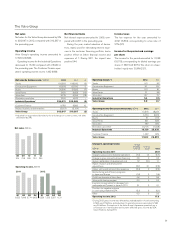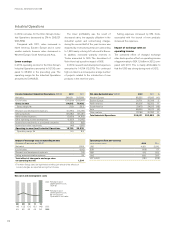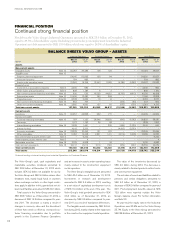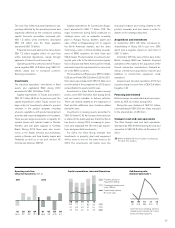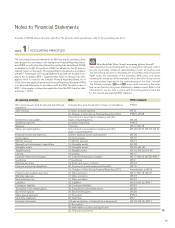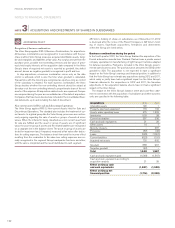Volvo 2012 Annual Report Download - page 104
Download and view the complete annual report
Please find page 104 of the 2012 Volvo annual report below. You can navigate through the pages in the report by either clicking on the pages listed below, or by using the keyword search tool below to find specific information within the annual report.
Consolidated financial statements
Principles for consolidation
The consolidated financial statements have been prepared in accordance
with the principles set forth in IAS 27, Consolidated and Separate Financial
Statements. Accordingly, intra-group transactions and gains on transac-
tions with associated companies are eliminated. The consolidated finan-
cial statements comprise the Parent Company, subsidiaries, joint ventures
and associated companies.
– Subsidiaries are defined as companies in which the Volvo Group holds
more than 50% of the voting rights or in which Volvo Group otherwise
has a controlling interest.
– Joint ventures are companies over which Volvo Group has joint control
together with one or more external parties. Up and until December 31,
2012 joint ventures are recognized using the proportionate method of
consolidation.
– Associated companies are companies in which Volvo Group has a sig-
nificant influence, which is normally when Volvo Group’s holding of
shares correspond to at least 20% but less than 50% of the voting
rights. Holdings in associated companies are recognized in accordance
with the equity method.
Translation to Swedish kronor when consolidating companies using
foreign currencies
AB Volvo’s functional currency is the Swedish krona (SEK). The functional
currency of each Volvo Group company is determined based on the pri-
mary economic environment in which it operates. The primary economic
environment is normally the one in which the company primarily generates
and expends cash. In most cases, the functional currency is the currency
of the country where the company is located. AB Volvo’s and the Volvo
Group’s presentation currency is SEK. In preparing the consolidated
financial statements, all items in the income statements of foreign sub-
sidiaries and joint ventures (except for subsidiaries in hyperinflationary
economies) are translated to SEK at monthly exchange rates. All balance-
sheet items are translated at exchange rates at the respective year-ends
(closing rate). The differences in consolidated shareholders’ equity, arising
from variations between closing rates for the current and preceding year
are charged or credited to other comprehensive income as a separate
component.
The accumulated translation difference related to a certain subsidiary,
joint venture or associated company is reversed to the profit or loss state-
ment as a part of the gain/loss arising from the divestment or liquidation
of such a company.
Receivables and liabilities in foreign currency
Receivables and liabilities in foreign currency are measured at closing
rates. Translation differences on operating assets and liabilities are rec-
ognized in operating income, while translation differences arising in finan-
cial assets and liabilities are charged to other financial income and
expenses. Financial assets and liabilities are defined as items included in
the net financial position of the Volvo Group (see Definitions at the end of
this report). Derivative financial instruments used for hedging of exchange
and interest risks are recognized at fair value. Gains on exchange rates
are recognized as receivables and losses on exchange rates are recog-
nized as liabilities. Depending on the lifetime of the financial instrument,
the item is recognized as current or non-current in the balance sheet.
Exchange rate differences on loans and other financial instruments in
foreign currency, which are used to hedge net assets in foreign subsidiaries
and associated companies, are offset against translation differences in
the shareholders’ equity of the respective companies. Exchange-rate
gains and losses on assets and liabilities in foreign currencies, both on
payments during the year and on measurements at year-end, impact profit
or loss in the year in which they are incurred. The more important exchange
rates applied are shown in the table.
Exchange rates Average rate Closing rate
as of Dec 31
Country Currency 2012 2 011 2012 2 011
Brazil BRL 3.4837 3.8850 3.1885 3.7109
Euro Zone EUR 8.7145 9.0430 8.6259 8.9540
Japan JPY 0.0851 0.0817 0.0757 0.0892
Canada CAD 6.7827 6.5694 6.5536 6.7808
China CNY 1.0738 1.0057 1.0456 1.0998
Great Britain GBP 10.7402 10.4179 10.4977 10.6831
South Korea KRW 0.0060 0.0059 0.0061 0.0060
United States USD 6.7767 6.4982 6.5169 6.9247
New accounting principles for 2012
None of the new accounting principles or interpretations effective from
January 1, 2012 has had any significant impact on the Volvo Group’s
financial statements.
New disclosure requirements in accordance with the amendement of
IFRS 7 Disclosures - Transfers of Financial Assets are presented in note 30.
The Swedish Financial Reporting Board has published an amendment
in RFR 2 regarding group contribution which is effective for the annual
period beginning January 1, 2013. This amendment has been early
adopted by the parent company in 2012. AB Volvo applies the alternative
rule and group contributions are recognized as allocations in the income
statement. Previously, group contributions were recognized as income
from investments in group companies. The comparative numbers in the
2011 income statement for the parent company have been adjusted.
Other amendments in RFR 2 effective from January 1, 2012 have not
had any significant impact on the parent company’s financial statements.
New accounting principles for 2013 and later
When preparing the consolidated financial statements as of December
31, 2012, a number of standards and interpretations has been published,
but has not yet become effective. See note 31 for information related to
Amendment to IAS 19 Employee benefits and IFRS 11 Joint Arrange-
ments and restated income statement and balance sheet for 2012 in
accordance with the two above mentioned standards.
Read more in Note 31 regarding changes in the financial reporting as from
January 1, 2013.
The following is an assessment of the effect that the implementation of
other new standards and statements could have on the Volvo Group’s
financial statements.
NOTES TO FINANCIAL STATEMENTS
FINANCIAL INFORMATION 2012
100



